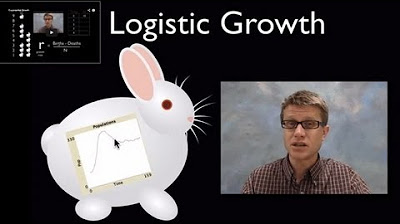r-selected and K-selected population growth strategies | High school biology | Khan Academy
Summary
TLDRThis video explains different population growth strategies of species, focusing on the distinction between K-selected and R-selected species. K-selected species, such as elephants and humans, are long-lived, have fewer offspring, and are limited by resources, while R-selected species, like frogs and insects, reproduce quickly with many offspring and are influenced by environmental factors. The video also highlights how invasive species tend to be more R-selected, and it briefly touches on the difference between population growth strategies and niche strategies, setting up for future discussions.
Takeaways
- 🐘 Species like elephants and killer whales are long-lived, similar to humans, and have slow reproduction rates.
- 👶 K-selected species, like large mammals, have few offspring at a time and invest significant care in their young.
- 🕷️ R-selected species, like frogs and insects, have short lifespans but produce many offspring in each reproductive event.
- 🌍 R-selected species often rely on environmental factors, like temperature and moisture, to determine their reproductive success.
- 📈 Population growth in R-selected species is typically exponential when resources are abundant, represented by the letter R in the growth equation.
- 📉 K-selected species reach a carrying capacity (K) where competition for resources limits their population growth.
- 🐢 Some species, like turtles, don't fit neatly into either category—they have traits from both R and K strategies.
- 🦠 Invasive species tend to be R-selected, growing rapidly and being less limited by competition within their own population.
- 🐅 K-selected species are often more vulnerable to invasive species due to their slower reproduction and population growth rates.
- 🌿 Population growth strategies (R and K) are separate from niche strategies, which involve how species utilize available resources.
Q & A
What is the main topic of the video?
-The video discusses different population growth strategies among species, focusing on two broad categorizations: K-selected and R-selected species.
What are examples of K-selected species mentioned in the video?
-Examples of K-selected species mentioned in the video include elephants, killer whales, humans, and gorillas.
What characteristics define K-selected species?
-K-selected species tend to be large, long-lived, produce few offspring per reproductive event, and invest significant time in raising their offspring. Their population growth is typically limited by resource availability.
What are R-selected species, and what examples were given?
-R-selected species are typically short-lived, small, and produce many offspring at once, such as frogs, spiders, mosquitoes, and bacteria.
How do R-selected species’ populations grow compared to K-selected species?
-R-selected species experience rapid, exponential population growth based on environmental factors like temperature and moisture, rather than being limited by competition for resources as in K-selected species.
Where do the terms 'R' and 'K' come from in population biology?
-'R' refers to the rate of population growth (biotic potential) in R-selected species, while 'K' represents the carrying capacity in K-selected species. The term 'K' is derived from a German word for capacity.
What happens to the population of K-selected species when resources become limited?
-When resources become limited, the population of K-selected species stabilizes at the carrying capacity, which is the maximum population size the environment can support.
Can all species be strictly categorized as K-selected or R-selected?
-No, the video mentions that nature is complex, and some species, like turtles, exhibit traits of both categories. Turtles, for example, lay many eggs like R-selected species but live long lives like K-selected species.
How do invasive species fit into the K vs. R selection framework?
-Invasive species are typically R-selected, meaning they reproduce rapidly and are limited more by environmental factors than by competition with other species, often outcompeting native K-selected species.
What is the difference between population growth strategies and niche strategies?
-Population growth strategies refer to how species grow in population (K-selected vs. R-selected), while niche strategies refer to how species occupy different ecological roles or niches in their environment.
Outlines

Esta sección está disponible solo para usuarios con suscripción. Por favor, mejora tu plan para acceder a esta parte.
Mejorar ahoraMindmap

Esta sección está disponible solo para usuarios con suscripción. Por favor, mejora tu plan para acceder a esta parte.
Mejorar ahoraKeywords

Esta sección está disponible solo para usuarios con suscripción. Por favor, mejora tu plan para acceder a esta parte.
Mejorar ahoraHighlights

Esta sección está disponible solo para usuarios con suscripción. Por favor, mejora tu plan para acceder a esta parte.
Mejorar ahoraTranscripts

Esta sección está disponible solo para usuarios con suscripción. Por favor, mejora tu plan para acceder a esta parte.
Mejorar ahora5.0 / 5 (0 votes)






